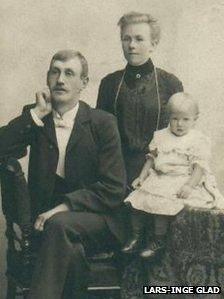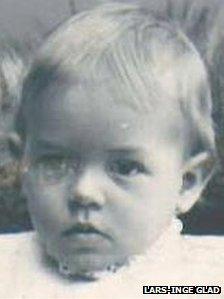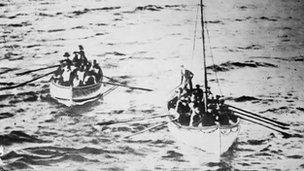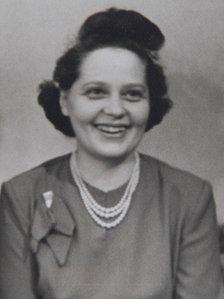Titanic centenary: Swedish dreams of a new life lost at sea
- Published

Alma Pålsson was going to join her husband who had already emigrated
In the days after the Titanic sank with the loss of 1,517 lives, the Chicago Daily Tribune published an account of how Swedish immigrant and city tram conductor Nils Pålsson discovered his wife Alma and four children had perished in the waters of the Atlantic.
"Paulson looked pale and ill when he leaned hungry-eyed over the desk and asked in broken English if his wife or children had been accounted for.
"Chief clerk Ivar Holmstrom scanned his list of third-class passengers saved.
"He failed to find there any of the names enumerated by Paulson. 'Perhaps they did not sail,' he suggested hopefully.
"Then he looked over the list of those who sailed third class on the Titanic...The process of elimination was now complete.
"Your family was on the boat, but none of them are accounted for," said Clerk Holmstrom.
"The man on the other side of the counter was assisted to a seat. His face and hands were bathed in cold water before he became fully conscious.
"He was finally assisted to the street by Gust Johnson, a friend who arrived with him.
"Paulson's grief was the most acute of any who visited the offices of the White Star, but his loss was the greatest.
"His whole family had been wiped out."
A million emigrants
During the 19th Century failing crops and rising poverty levels made many Swedes sell up to start a new life across the Atlantic.
.jpg)
The passenger list with the 'Paulson' family names and their ages on it
Between the early 1800s and 1930 more than one million Swedes left for America.
Most sailed from Southampton or Liverpool to New York.
On the Titanic, the Swedes were the largest group after British and American passengers, making Swedish the second most spoken language on board, according to Titanic expert and author Claes-Göran Wetterholm.
"There were more than 200 Nordic passengers and they made up almost a third of all third-class passengers," he explained.
Of the estimated 1,300 passengers on board the Titanic, there were 123 Swedes, 112 in third class. There were 327 British and 306 American passengers on board.
Nils Pålsson, a miner, left his home in Bjuv, Skåne, south Sweden, in June 1910 for Chicago where he got a job as a tram conductor.
Unknown child's grave
By April 1912 he had enough money to pay for Alma Pålsson, 29, and their children Gösta Leonard, two, Stina Viola, three, Paul Folke, five, and Torborg Danira, eight, to join him.
They travelled via Copenhagen to England and Southampton where they boarded Titanic.
As the ship began to sink late on 14 April Alma dressed her children in their cabin.
But they arrived on deck too late for the lifeboats and all of them died that night.
Alma's body was recovered but none of her children was found.

Gösta Pålsson was long thought to be the unknown child buried at Fairview
In the days after the disaster the body of a fair-haired little boy was found floating in the water near the site of the sinking.
He was never identified and was buried at Fairview Cemetery in Halifax, Canada. His gravestone read: "Erected to the memory of an unknown child".
Lars-Inge Glad, a descendant of Nils Pålsson, said: "For many years it was believed that the 'unknown child's grave' belonged to one of Alma's children but it turned out to be an English child from third class."
The grave, which is near Alma's grave at Fairview Cemetery, was identified in 2007 as that of Sidney Leslie Goodwin, a 19-month-old boy from Wiltshire.
Mr Glad said: "Nils never recovered from losing his family, but he remarried another Swedish woman called Christina.
"They moved from Chicago to a place not that far away where they bought a house where Nils planted four trees in the garden in memory of his wife and children.
Nils later changed his surname to Paulson to make it sound more American.
"He died in 1964. The names of their children have been kept alive in our family. My mother's second name was Viola and my grandmother was called Torborg."
The lost ring
The story of another Swedish victim will live on through her wedding ring.
Gerda Lindell, 30, was also emigrating to America with her husband Edvard, 36, on the Titanic.
The couple, from Helsingborg, Skåne, managed to stay together as the Titanic went down and reached collapsible lifeboat A together.

Gerda Lindell's ring ended up drifting around in a lifeboat for a month before it was found
August Wennerström, one of only 34 surviving Swedes, later described the events to many newspapers.
He said he and Edvard managed to get into the lifeboat but Gerda had no strength left to climb in and clung on to the side.
Eventually she could hold on no longer and drowned.
Wennerström described how Edvard's hair "turned all grey in lesser time than 30 minutes" before he died, still holding his wife's ring in his hand.
The survivors were later transferred to another lifeboat and taken to Carpathia while the collapsible was left to drift away.
Gerda's body was never found, nor was her husband's.
But a month later a crew from another ship, Oceanic, found the drifting lifeboat about 300 miles from where the Titanic sank.
Last Swedish survivor
As they began recovering three dead bodies from the raft, they saw something glistening at the bottom. They had found Gerda Lindell's ring.
The ring was reunited with her father in Sweden after her brother saw a note about it in a local newspaper.
For many years the ring, which was a combined wedding and engagement ring, remained in the family and Gerda's niece wore it.

Lillian Asplund became the last survivor to die in America in 2006
Mr Wetterholm had heard the story about the ring but until he managed to trace it in 1991 he thought it was a myth.
The ring is now stored in a safety deposit box in Sweden, but is taken out for exhibitions around the world.
Another well known Swede on board was Lillian Asplund.
She is better known as the last American survivor, although she was actually from Sweden.
Having been born in the US in 1906 to immigrant parents, the family returned to Småland in Sweden in 1907 to sort out the family farm after her grandfather's death.
By 1912 they decided to move back to the US and Mr Asplund booked them on the Titanic.
Lillian survived along with her mother Selma and younger brother Felix and were rescued by Carpathia. Her father and three older brothers died.
Lillian Asplund never wanted to to talk about the events of that fateful night. She died in 2006 at the age of 99.